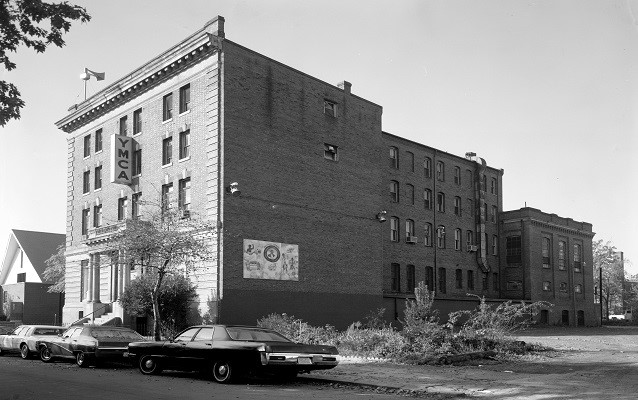Last updated: August 11, 2017
Place
Twelfth Street YMCA

The Twelfth Street Young Men’s Christian Association (YMCA) building, located in the Shaw neighborhood of Washington, DC, housed the first African-American YMCA in the United States. Founded in England in 1844, the YMCA movement promoted the mental, physical, social and religious development of young urban boys. It gained popularity in the United States as a positive community-building organization to combat of new problems associated with modernization and urbanization, like poverty and overcrowding. In 1853, educator and religious leader Anthony Bowen founded the Colored Young Men’s Christian Association. During slavery, Reconstruction and Jim Crow, this branch was a safe haven for the DC black community. After occupying several rented locations in the city, in 1912 the Y moved to a new building on Twelfth Street, NW. For seven decades, the Twelfth Street YMCA provided unwavering support and opportunity for and created by the black community in an era of inequality and violence.
In 1805, Anthony Bowen was born into slavery in Prince George’s County, MD. After moving to Washington, DC, he bought his freedom at age 25. He founded St. Paul AME Church from his Southwest Washington, DC home. He also helped found Wesley Sion Sunday School, where he taught children and adults to read. Bowen harbored runaway slaves in his home, often meeting boats at the 6th Street Wharf. Bowen also worked as a clerk in the U.S. Patent Office, where he met the founder of the white YMCA in DC, William Chauncey Langdon. Black people were not permitted to join Langdon’s Y.
Reverend Bowen founded the black YMCA in 1853. From the beginning, he faced racial prejudice from the larger YMCA organization. They refused to provide financial support. As president of the Y, Bowen funded the project with his own money. For 38 years, Bowen’s YMCA did not have a permanent home, operating out of rented or donated spaces. After a successful 1891 fundraising campaign, the black YMCA rented a building on 11th Street, NW. One year later, it was officially incorporated into the YMCA organization. Yet, in 1897, decreasing membership forced the group to move to a smaller building on U Street. Seven years later, new white and black Y leadership helped boost membership to approximately 600 people.
In 1905, plans began for the construction of a permanent location on Twelfth Street. Large contributions from John D. Rockefeller and Julius Rosenwald aided the project, but neighborhood residents raised the majority of funds. Designed by the African-American architect William Sidney Pittman of Washington, DC, the building cost $100,000. President William Howard Taft participated in a fundraiser at the Howard Theater, a black theater located just down the street. President Theodore Roosevelt laid the cornerstone in 1908. A brochure from the time boasts that only black laborers constructed the building. A stone above the front entrance to the four-story brick Renaissance Revival-style building reads “Young Men’s Christian Association.” Opened in 1912, the building had the amenities of a full-service YMCA facility including reception rooms, offices, 54 sleeping rooms, a heated swimming pool and a gymnasium.
Beyond athletics, social and political initiatives often began at the Twelfth Street Y. Members attended parties and lectures. Young men stayed overnight in the dormitories. While renting a room in the 1920s, Langston Hughes published his first works of poetry. Local churches also used the pool for baptisms. Many prominent African-American innovators visited this Y, including Charles Drew, the first African American to receive a Doctorate of Science in Medicine and groundbreaking scientist of blood transfusions. Y member Thurgood Marshall held Civil Rights planning meetings here. The Twelfth Street YMCA quickly became an anchor of the community.
In 1972, the branch was re-named the Anthony Bowen YMCA after its founder. Members organized a Community Chest Program to supply needy families with vital goods. The Y also created a Traveler’s Aid Committee, which helped black travelers find safe lodging, food and entertainment. In 1982, the Bowen Y closed because of financial problems and declining membership. It re-opened years later on W Street, NW. The Anthony Bowen Landmark Building Trust acquired ownership of the Twelfth Street building. In the 1990s, the building went through extensive renovations. Today, the Thurgood Marshall Center for Service and Heritage occupies the site. The center’s purpose echoes Bowen’s original goals of social organizing and community support. The campaign to build and fund the Twelfth Street YMCA building became the prototype for African-American YMCAs across the nation. The building stands as a reminder of the DC African American community’s perseverance to create the resources and programs not available to them through any other organization.
Sources:
Fitzpatrick, Sandra and Mark Goodwin. The Guide to Black Washington: Places and Events of Historical and Cultural Significance in the Nation’s Capital. New York: Hippocrene Books, 2001.
Russell, Hilary. “Final Research Report: The Operation of the Underground Railroad in Washington, D.C., c. 1800-1860.” Washington, DC: Historical Society of Washington and National Park Service, 2001.
Williams, Paul K. Greater U Street. Charleston, SC: Arcadia, 2002.
National Historic Landmark Nomination of the Twelfth Street YMCA.
National Historic Landmarks (NHLs) are historic places that possess exceptional value in commemorating or illustrating the history of the United States. The National Park Service’s National Historic Landmarks Program oversees the designation of such sites. There are just over 2,500 National Historic Landmarks. All NHLs are also listed in the National Register of Historic Places.
